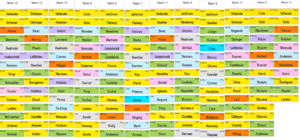2020 Snake Drafting, Pocket Aces and BABS
by Pat Cloghessy
“You can’t win your league early in the draft, but you can lose it”.
“Don’t go in with a rigid plan, let the draft come to you”.
“I don’t care what pick I have, I can draft from anywhere”.
This is just a sampling of the fantasy baseball draft aphorism list. You’ve heard them all.
Then there are the strategies: value-based drafting, the LIMA plan, Portfolio3 and others.
If you follow “fantasy baseball twitter”, you may have come across the “pocket aces” draft strategy. This is often employed by drafters toward the end of Round 1, though selectors of Gerrit Cole and Jacob deGrom are not immune to it. If picking near the 1st/2nd round wheel, the arms utilized for this strategy are usually some combination of Justin Verlander (ER,K+), Max Scherzer (ER,K+), Walker Buehler (ER,KK) and even Jack Flaherty (ER,KK). This game plan provides an extra heavy anchor to pitching stats. But how does the draft go after that?
Rather than parse through ADP numbers to try guess who might be available if we employ a pocket aces strategy, we head over to The Great Fantasy Baseball Invitational, which provides complete draft boards for all of its 26 leagues. These are snake-style slow drafts taking place right now, done by people from within the fantasy baseball industry. This may be the largest and most aggregated sample of fantasy baseball touts practicing what they preach (or not).
In this contest, there are 15 teams in each league. This gives us 390 unique drafts to examine. There were 10 different drafts in which the pocket aces strategy was employed. In two of the 10 we saw it done twice. That’s a total of 12 implementations of a SP/SP start in rounds 1-2. With only three percent of drafters choosing the pocket aces blueprint, this is definitely a case of zigging while others are zagging. Here’s how it plays out in practice (click image to enlarge):
Consistent within this approach is the wait on pitching after the two aces are rostered. No surprise here. Not a single team drafted another starting pitcher prior to round 8, with some waiting even longer.
Since we see only 15 rounds from each draft (save one), full analysis would be a bit presumptuous. What we do see, though, is that this game plan leaves rosters mostly without any triple-asset players. The ability to draft them is diminished by the simple fact that most triple threats go off the board before these strategists’ 3rd round pick. This is not the end of the world, but it’s probably the biggest BABSian sacrifice made in the interest of double barreling starting pitching at the top of a snake draft.
Drafting Javier Baez (p,s,a) or Ramon Laureano (p,s,a) would be a way of approximating those upper echelon triple threats that were eschewed earlier in the draft. Another triple-asset player who wound up absent from all of these squads is Bo Bichette (p,SB,AV). Bichette, in BABS’ estimation, has the upside to provide top shelf stats in the class normally reserved for first or second round players. At his price, Bichette could be a prime target for those that choose to employ the pocket aces draft plan.
The most common formula after the twin pitchers are chosen is stockpiling bats, often with Rounds 3 and 4 being comprised of some combination of a power bat and speed player. Nothing earth-shattering here. One issue that may arise is that the portion of the draft from which this plan accumulates bats (Rounds 3-7) can be bereft of teams drafting pitchers. Meaning that there may not be any inherent advantage drawn from selecting the aces at the front. You’d still be competing against virtually everyone in Rounds 3-7 for the best remaining bats. Additionally, if some pitchers get pushed from Round 3 to Round 4, the 3rd round choices for your first batter are reduced.
If willing to take the risk (and it does appear to carry some risk), then this is the type of program that could pay off in larger contests where you compete not only against your league, but against all other leagues for a grand championship. It’s in the low percentage of implementation, or the “zigging” while others are “zagging”, that the leverage may lie. Still, it will take a lot more than just snagging two aces to win a contest like that.
The intrinsic uncertainty of snake drafts prevents many pre-draft strategies from being viable. Pocket aces work in practice mostly because two or more SP are almost always available near the 1-2 turn.
Otherwise, entering one of these drafts with a pre-formulated plan is doomed to fail. And if it doesn’t, the drafter could be missing out on profit and value by stubbornly adhering to a static plan, when snake drafts are always and inherently dynamic. Hence the cliches and aphorisms at the top of this piece.
So call shenanigans on the plans, if you wish. Follow BABS and let your competitors fight it out for the (p,a) asset guys at pick 36 or even 66, while you lie in wait to nab Nick Castellanos (PW,AV) and Michael Conforto (PW,a) nearer pick 100 (or later). Steer clear (as much as possible) from liabilities early, leaving risk accumulation for later, when high upside is cheaper and it’s easier to stomach the downside.


